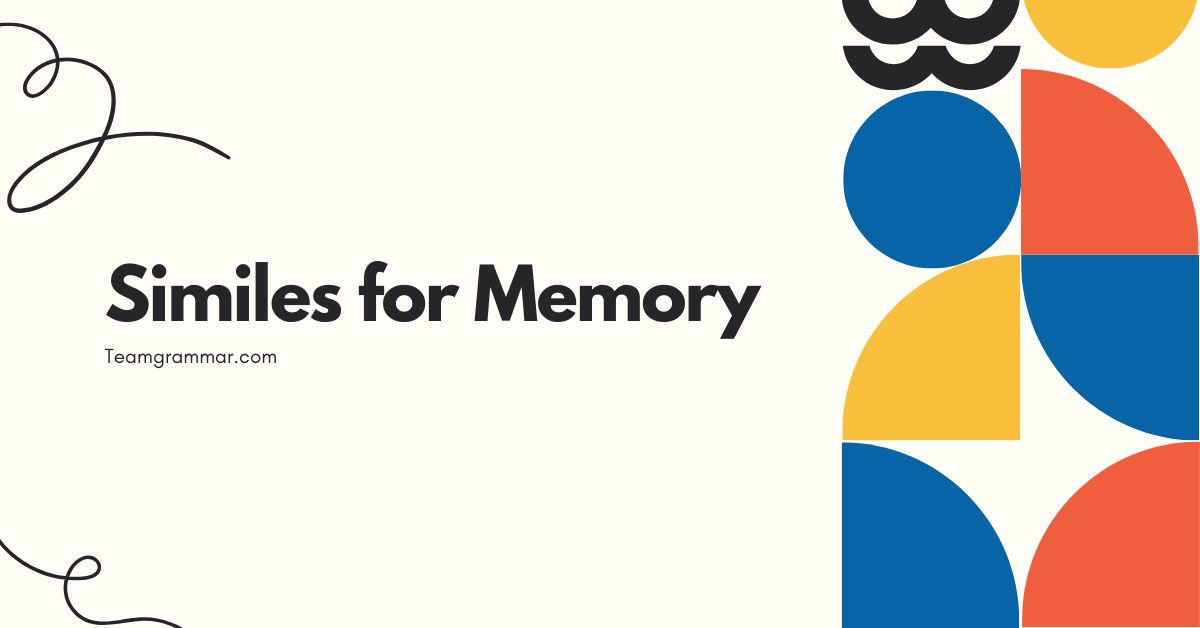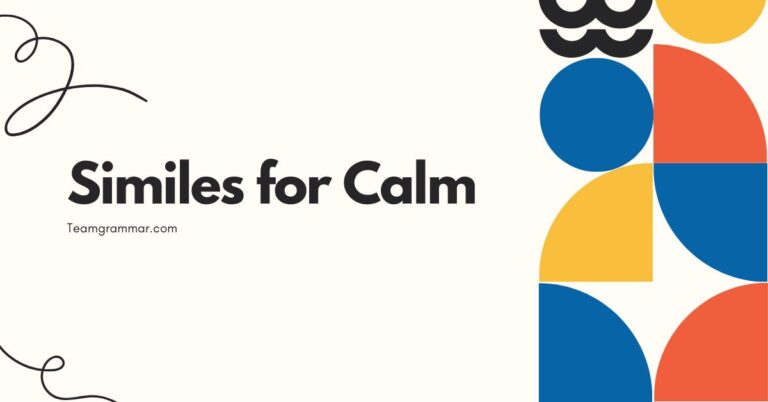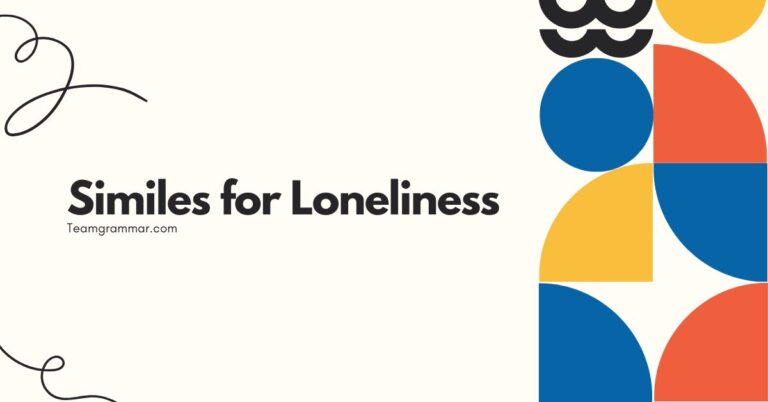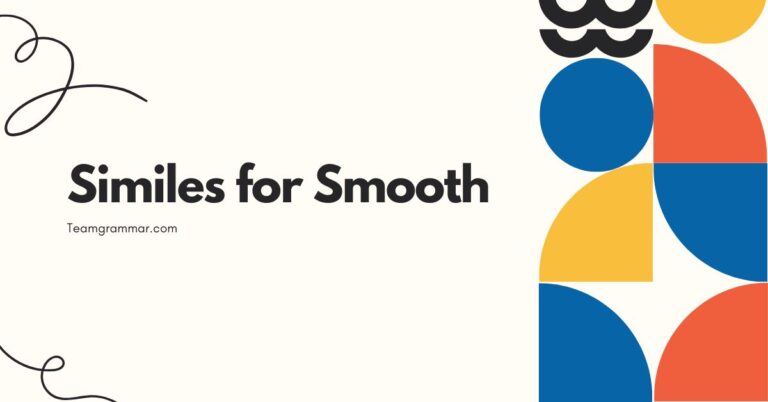29 Similes for Memory: Enhancing Recall Through Figurative Language
Understanding similes is crucial for effective communication and memory retention. Similes, a type of figurative language, create vivid comparisons that make information more memorable.
This article explores the definition, structure, types, and usage of similes, providing numerous examples and practice exercises to help you master this powerful tool. Whether you’re a student, writer, or simply looking to improve your memory, this comprehensive guide will equip you with the knowledge and skills to use similes effectively.
Similes are essential for enriching language and making it more engaging. By drawing comparisons between different things, similes can help clarify complex concepts and make them easier to remember.
This article is designed to provide a thorough understanding of similes and their application in enhancing memory and communication. From basic definitions to advanced usage, this guide offers a complete learning experience for anyone interested in mastering this figurative language technique.
This guide is perfect for students studying literature, writers aiming to add depth to their work, and anyone interested in improving their memory and communication skills. By understanding how similes work and practicing their use, you can significantly enhance your ability to recall information and express yourself more effectively.
This article provides a structured approach to learning similes, with clear explanations, diverse examples, and practical exercises.
Table of Contents
- Definition of Simile
- Structural Breakdown of Similes
- Types of Similes
- Examples of Similes
- Usage Rules for Similes
- Common Mistakes with Similes
- Practice Exercises
- Advanced Topics in Similes
- Frequently Asked Questions
- Conclusion
Definition of Simile
A simile is a figure of speech that directly compares two unlike things using the words “like” or “as.” The purpose of a simile is to create a vivid image or emphasize a particular quality by associating it with something familiar. Similes are widely used in literature, poetry, and everyday conversation to add color and depth to language.
Unlike metaphors, which state that one thing *is* another, similes only suggest a resemblance.
Similes function by highlighting a shared characteristic between two disparate entities. This comparison helps the audience understand the subject more clearly and remember it more easily.
For example, saying “He runs like the wind” uses the speed of the wind to emphasize the subject’s running ability. The comparison makes the image more striking and memorable than simply saying “He runs fast.” The key is that the two things being compared are inherently different, making the comparison insightful and interesting.
The context in which a simile is used can significantly impact its effectiveness. A well-chosen simile can enhance the emotional impact of a scene, clarify a complex idea, or add humor to a situation.
For instance, in a poem, a simile might evoke a sense of longing or nostalgia. In a scientific explanation, a simile could simplify a difficult concept by relating it to something familiar.
In everyday conversation, similes often add a touch of creativity and personality to one’s speech.
Structural Breakdown of Similes
The basic structure of a simile includes three core components: the subject, the linking word (either “like” or “as”), and the object of comparison. The subject is the thing being described.
The linking word establishes the comparison. The object of comparison is the thing to which the subject is being compared.
The formula can be represented as:Subject + Linking Word + Object of Comparison. For example, in the simile “Her smile is like sunshine,” “her smile” is the subject, “like” is the linking word, and “sunshine” is the object of comparison.
This structure clearly and concisely draws a parallel between the subject and the object, allowing the reader to understand the intended meaning.
Understanding this structure is essential for creating effective similes. By carefully selecting the subject and object of comparison, and using the appropriate linking word, you can craft similes that are both meaningful and memorable.
The strength of a simile lies in the aptness of the comparison and its ability to evoke a specific image or feeling in the reader’s mind. A poorly constructed simile can be confusing or ineffective, so it’s important to pay attention to each component of the structure.
Types of Similes
Similes can be categorized based on the nature of the comparison they make. Here are some common types:
Positive Similes
Positive similes emphasize a positive quality or attribute of the subject by comparing it to something that is generally considered positive. These similes often evoke feelings of admiration, appreciation, or happiness.
These are used to highlight desirable traits, making the description more appealing and memorable. They help create a favorable impression of the subject being described.
Negative Similes
Negative similes highlight a negative quality or attribute of the subject by comparing it to something unpleasant or undesirable. These similes often evoke feelings of disgust, disapproval, or sadness.
These are used to emphasize undesirable traits, creating a negative impression of the subject being described. They can be powerful tools for criticism or satire.
Ironic Similes
Ironic similes use comparison in a way that conveys the opposite of the literal meaning. These often involve comparing something to an object that one would not normally associate with the subject.
These are often used for humorous or satirical effect, highlighting the discrepancy between expectation and reality.
Examples of Similes
Here are several examples of similes, categorized by the quality they emphasize:
Similes for Speed
These similes emphasize the speed of a subject by comparing it to something known for its quickness. These can be used to describe movement, actions, or even the pace of events.
The following table provides a list of similes that relate to speed, offering various ways to express how fast something is moving or occurring.
| Simile | Meaning |
|---|---|
| As fast as a cheetah | Extremely quick |
| Like a shot from a gun | Moving very rapidly |
| Quick as lightning | Instantaneous speed |
| Swift as an arrow | Moving with great speed and precision |
| Fast like a rocket | Accelerating quickly |
| Like a speeding bullet | Moving at an incredibly high velocity |
| As quick as a wink | Happening in an instant |
| Fast as greased lightning | Extremely fast and slippery |
| Like a whirlwind | Moving with chaotic speed |
| Speedy as a race car | Capable of high speeds |
| As fast as thought | Occurring almost instantaneously |
| Like a flash | Appearing or disappearing very quickly |
| As swift as a coursing river | Flowing rapidly |
| Like a runaway train | Uncontrollably fast |
| Quick as a bunny | Moving with agility and speed |
| Fast as a shadow | Moving discreetly and quickly |
| Like a dart | Moving sharply and quickly |
| Speedy as a hummingbird | Moving wings rapidly |
| As fast as a jackrabbit | Hopping away quickly |
| Like a streak of light | Moving with intense speed and brightness |
| Quick as a computer processing data | Processing information rapidly |
| Fast as news travels online | Spreading information quickly |
| Swift as a digital download | Completing a task in moments |
Similes for Brightness
These similes emphasize the brightness of a subject by comparing it to something that is known for its luminosity. These can be used to describe light sources, colors, or even the radiance of a person’s smile.
The following table provides a list of similes that relate to brightness, offering various ways to express how radiant or luminous something is.
| Simile | Meaning |
|---|---|
| As bright as the sun | Extremely radiant |
| Like a shining star | Luminous and prominent |
| Bright as a diamond | Sparkling intensely |
| Radiant like the moon | Glowing gently and softly |
| Bright as a light bulb | Providing strong illumination |
| Like a beacon in the night | Guiding and illuminating |
| As luminous as a firefly | Emitting a soft glow |
| Bright as polished gold | Reflecting light brilliantly |
| Like a sunbeam | Warm and radiant |
| Bright as a neon sign | Vibrant and eye-catching |
| As clear as crystal | Pure and transparent |
| Like a supernova | Explosively bright |
| Radiant as a sunrise | Beautiful and promising |
| Bright as a spotlight | Focused and intense |
| Like a shimmering pearl | Gleaming softly |
| Bright as a flashlight | Providing direct light |
| As luminous as a candle | Providing gentle illumination |
| Bright as a mirror | Reflecting light perfectly |
| Like a glittering gem | Sparkling with color |
| Bright as a laser beam | Focused and powerful |
| As clear as daylight | Easy to see and understand |
| Like a lighthouse | Providing guidance in darkness |
| Radiant as a smile | Expressing happiness and warmth |
Similes for Coldness
These similes emphasize the coldness of a subject by comparing it to something that is known for its frigidity. These can be used to describe temperature, emotions, or even a person’s demeanor.
The following table provides a list of similes that relate to coldness, offering various ways to express how icy or frigid something is.
| Simile | Meaning |
|---|---|
| As cold as ice | Extremely frigid |
| Like a frozen tundra | Barren and icy |
| Cold as a winter’s night | Bitterly cold |
| Frigid like a glacier | Extremely cold and slow-moving |
| Cold as a refrigerator | Chilled and preserved |
| Like an arctic breeze | Sharp and biting |
| As icy as a snowman | Covered in ice and snow |
| Cold as a stone | Unfeeling and hard |
| Like a block of ice | Solid and unyielding |
| Cold as the grave | Deathly cold |
| As chilly as an autumn wind | Slightly cold and crisp |
| Like a winter storm | Severe and unforgiving |
| Frigid as a morgue | Extremely cold and lifeless |
| Cold as a deep freeze | Preserved at very low temperatures |
| Like a snowflake | Delicate and icy |
| Cold as metal | Unresponsive and hard |
| As icy as a stare | Unfriendly and aloof |
| Like a frozen heart | Emotionally distant |
| Cold as liquid nitrogen | Extremely cold and volatile |
| Frigid as space | Vast and cold |
| As cold as a clam | Emotionally unresponsive |
| Like a frozen lake | Still and icy on the surface |
| Cold as charity | Lacking in warmth or generosity |
Similes for Happiness
These similes emphasize the happiness of a subject by comparing it to something that is known for its joyfulness. These can be used to describe feelings, expressions, or even entire situations.
The following table provides a list of similes that relate to happiness, offering various ways to express how joyful or cheerful something is.
| Simile | Meaning |
|---|---|
| As happy as a lark | Extremely joyful and carefree |
| Like a kid in a candy store | Excited and delighted |
| Happy as a clam | Content and satisfied |
| Joyful like a songbird | Singing with joy |
| Happy as can be | Extremely cheerful |
| Like winning the lottery | Overjoyed and fortunate |
| As pleased as punch | Very satisfied and happy |
| Happy as a sunflower | Radiant and cheerful |
| Like a dream come true | Incredibly happy and fulfilled |
| Happy as a puppy with two tails | Exuberantly joyful |
| As giddy as a schoolgirl | Excited and lighthearted |
| Like floating on air | Feeling weightless and happy |
| Happy as a king | Feeling powerful and content |
| Joyful as a summer’s day | Warm and pleasant |
| Like finding a treasure | Excited and rewarded |
| Happy as a bee in clover | Content and busy |
| As cheerful as a daisy | Bright and optimistic |
| Like a burst of sunshine | Radiant and uplifting |
| Happy as a lark at dawn | Fresh and energetic |
| As content as a cat purring | Comfortable and at ease |
| Like a celebration | Festive and joyous |
| Happy as children playing | Carefree and delighted |
| As pleased as a peacock | Proud and happy |
Similes for Sadness
These similes emphasize the sadness of a subject by comparing it to something that is known for its sorrowfulness. These can be used to describe feelings, expressions, or even entire situations.
The following table provides a list of similes that relate to sadness, offering various ways to express how sorrowful or melancholic something is.
| Simile | Meaning |
|---|---|
| As sad as a willow tree | Drooping and mournful |
| Like a rainy day | Gloomy and depressing |
| Sad as a funeral | Mournful and solemn |
| Sorrowful like a lost child | Confused and distressed |
| Sad as can be | Extremely unhappy |
| Like a broken heart | Crushed and devastated |
| As blue as the ocean | Deeply sad and melancholic |
| Sad as a lonely wolf | Isolated and longing |
| Like a fading flower | Wilted and diminished |
| Sad as a prisoner | Trapped and hopeless |
| As forlorn as a ghost | Haunted and lost |
| Like a tear in the rain | Insignificant and fleeting |
| Sad as a beggar | Destitute and pathetic |
| Sorrowful as a dirge | Lamenting and mournful |
| Like a heavy burden | Weighing down and oppressive |
| Sad as a cloudy sky | Dark and ominous |
| As gloomy as a dungeon | Dark and confining |
| Like a wilted rose | Faded and lifeless |
| Sad as an orphan | Abandoned and lonely |
| As despondent as a shadow | Dark and lingering |
| Like a sigh in the wind | Quiet and regretful |
| Sad as an empty swing set | Vacant and nostalgic |
| As melancholic as twilight | Reflective and wistful |
Usage Rules for Similes
When using similes, there are several rules to keep in mind to ensure clarity and effectiveness:
- Use “like” or “as”: Similes always use these two words to make the comparison.
- Compare dissimilar things: The objects being compared should be different enough to make the comparison interesting and insightful.
- Ensure the comparison is clear: The shared characteristic should be evident to the reader.
- Avoid clichés: Overused similes can be boring and ineffective. Try to be original.
- Maintain consistency: The tone and style of the simile should match the overall tone of your writing.
Exceptions to these rules are rare, but sometimes, for stylistic effect, writers may bend or break them. However, it’s generally best to adhere to these guidelines, especially when learning to use similes effectively.
By following these rules, you can create similes that enhance your writing and make your message more memorable.
Special cases may arise when dealing with complex or abstract concepts. In such cases, it may be necessary to use more elaborate similes or to provide additional context to ensure that the comparison is understood.
However, the basic principles of clarity and relevance should always be maintained.
Common Mistakes with Similes
One common mistake is confusing similes with metaphors. A simile uses “like” or “as” to suggest a resemblance, while a metaphor states that one thing *is* another.
For example:
| Incorrect | Correct |
|---|---|
| The warrior *was* a lion. (Metaphor) | The warrior was *like* a lion. (Simile) |
Another common mistake is using clichés. Overused similes like “as busy as a bee” or “as blind as a bat” lack originality and impact.
Instead, try to create fresh and imaginative comparisons.
| Incorrect | Correct |
|---|---|
| He was as busy as a bee. | He was as busy as a one-armed paper hanger. |
A third mistake is making comparisons that are unclear or illogical. The shared characteristic between the two objects being compared should be obvious to the reader.
For example:
| Incorrect | Correct |
|---|---|
| The car was like a banana. (Unclear comparison) | The car was like a rocket, speeding down the highway. (Clear comparison) |
Practice Exercises
Complete the following similes with appropriate endings:
| Question | Answer |
|---|---|
| 1. He was as quiet as a _____. | 1. He was as quiet as a mouse. |
| 2. She sings like a _____. | 2. She sings like a nightingale. |
| 3. The snow was as white as _____. | 3. The snow was as white as cotton. |
| 4. The old house stood as still as _____. | 4. The old house stood as still as a statue. |
| 5. The children slept like _____. | 5. The children slept like logs. |
| 6. The river flowed as smooth as _____. | 6. The river flowed as smooth as glass. |
| 7. The athlete was as strong as _____. | 7. The athlete was as strong as an ox. |
| 8. The teacher was as wise as _____. | 8. The teacher was as wise as an owl. |
| 9. The joke fell as flat as _____. | 9. The joke fell as flat as a pancake. |
| 10. The detective was as sly as _____. | 10. The detective was as sly as a fox. |
Create your own similes based on the following prompts:
| Question | Answer |
|---|---|
| 1. Describe the sound of rain. | 1. The rain sounded like a thousand tiny drums beating on the roof. |
| 2. Describe the feeling of being nervous. | 2. Being nervous felt like having butterflies fluttering in my stomach. |
| 3. Describe the taste of chocolate. | 3. The chocolate tasted like a sweet and creamy dream. |
| 4. Describe the appearance of a sunset. | 4. The sunset looked like a painting of fire across the sky. |
| 5. Describe the speed of a race car. | 5. The race car moved like a bolt of lightning down the track. |
| 6. Describe the texture of silk. | 6. The silk felt like liquid moonlight against my skin. |
| 7. Describe the feeling of relief. | 7. Relief washed over me like a cool wave on a hot day. |
| 8. Describe the sound of laughter. | 8. Her laughter sounded like wind chimes in a gentle breeze. |
| 9. Describe the feeling of being exhausted. | 9. Being exhausted felt like carrying the weight of the world on my shoulders. |
| 10. Describe the appearance of stars in the night sky. | 10. The stars looked like diamonds scattered across a velvet cloth. |
Advanced Topics in Similes
Advanced learners can explore more nuanced aspects of similes, such as extended similes, which involve developing a comparison over several sentences or paragraphs. This technique allows for a more detailed and impactful comparison.
Another advanced topic is the use of similes in different literary genres, such as poetry, prose, and drama. Each genre has its own conventions and expectations, and the effective use of similes can vary accordingly.
Additionally, advanced learners can study the cultural and historical context of similes. Certain similes may have different meanings or connotations depending on the culture or time period in which they are used.
Understanding these nuances can enhance one’s appreciation of literature and improve one’s ability to communicate effectively across cultures.
Frequently Asked Questions
- What is the difference between a simile and a metaphor?
A simile uses “like” or “as” to compare two unlike things, suggesting a resemblance. A metaphor, on the other hand, states that one thing *is* another, implying a stronger connection. For example, “He is like a lion” is a simile, while “He is a lion” is a metaphor.
- Why are similes used in writing?
Similes are used to create vivid images, clarify complex ideas, and add depth and color to writing. They make language more engaging and memorable by drawing comparisons between familiar and unfamiliar things.
- How can I avoid using clichés in my similes?
To avoid clichés, try to be original and think of fresh and imaginative comparisons. Consider the specific qualities you want to emphasize and brainstorm unique objects or concepts that share those qualities.
- Can a simile be too long?
Yes, a simile can be too long if it becomes convoluted or distracting. The comparison should be clear and concise, and it should not overshadow the subject being described. Extended similes can be effective if used sparingly and with purpose.
- What is the purpose of using similes in poetry?
In poetry, similes are used to evoke emotions, create imagery, and enhance the overall aesthetic appeal of the poem. They add layers of meaning and allow the poet to express complex ideas in a concise and evocative way.
- Are similes only used in literature?
No, similes are used in various forms of communication, including everyday conversation, speeches, and advertisements. They are a versatile tool for making language more engaging and memorable in any context.
- How do I choose the right object of comparison for a simile?
Choose an object of comparison that shares a relevant characteristic with the subject you are describing. The comparison should be clear, logical, and evocative, and it should enhance the reader’s understanding or appreciation of the subject.
- What are some common examples of similes used in everyday language?
Some common examples of similes include “as busy as a bee,” “as blind as a bat,” “as strong as an ox,” and “as quiet as a mouse.” While these similes are widely understood, they can also be considered clichés.
- How can similes help improve memory?
Similes enhance memory by creating vivid and memorable associations. When you compare something unfamiliar to something familiar, it becomes easier to visualize and recall the information later. The more striking and relevant the comparison, the more effective it will be in aiding memory.
- Can similes be used in persuasive writing?
Yes, similes can be highly effective in persuasive writing. By drawing comparisons that resonate with the audience, you can make your arguments more compelling and memorable. Similes can help to clarify complex issues, evoke emotions, and create a sense of connection with the reader.
Conclusion
Similes are powerful tools for enhancing communication and improving memory. By understanding their structure, types, and usage rules, you can effectively incorporate similes into your writing and speech.
Remember to choose comparisons that are clear, original, and relevant to your audience. Avoid clichés and strive to create similes that add depth and color to your language.
Mastering the art of using similes requires practice and attention to detail. Experiment with different comparisons and pay attention to the impact they have on your audience.
By continuously refining your skills, you can become a more effective communicator and a more engaging writer. Similes are not just a literary device; they are a way to see the world in new and imaginative ways.
Continue to explore the world of figurative language and discover new ways to express yourself creatively. The more you practice, the more natural and intuitive the use of similes will become.
Remember, the goal is to make your language more vivid, memorable, and impactful, and similes are an excellent way to achieve that goal.







